The Model QH-50E
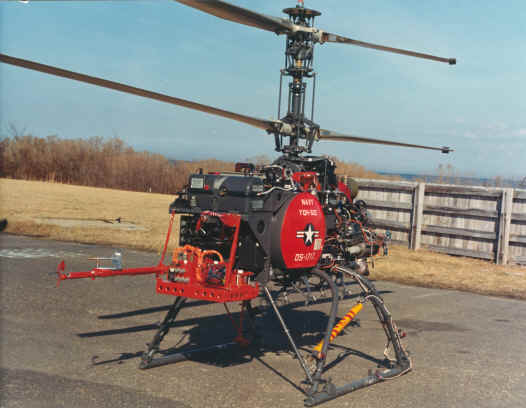 When Boeing ceased building its 365 shp
model 550-1 turbo-shaft engine (military designation T50-BO-12) in
April 1968, Gyrodyne sought other engines to power its dynamic rotor system and
provide the Navy the opportunity to not cancel the UAV program due to Boeing's
exit.
When Boeing ceased building its 365 shp
model 550-1 turbo-shaft engine (military designation T50-BO-12) in
April 1968, Gyrodyne sought other engines to power its dynamic rotor system and
provide the Navy the opportunity to not cancel the UAV program due to Boeing's
exit.
What began as the Allison powered YQH-50E test vehicle, as seen left,
became the QH-50E. The initial Allison T63-A-5A, Model 250-C19A, free turbine
type, gas turbine engine used in the YQH-50E, was rated at 317 SHP at sea level,
standard conditions.
The QH-50E was designed and fabricated
under Naval Air Systems Command Contract No. N00019-69-C-0361 which was
authorized by the United States Navy on December 31, 1968.
Although only three
aircraft were delivered to NATC, Patuxent River, Md. for stability and control
tests in 1969 under that contract, 3 subsequent QH-50D aircraft were later
converted into E's by the installation of the Allison power package. The QH-50E is currently the final variant of
the QH-50 series helicopter.
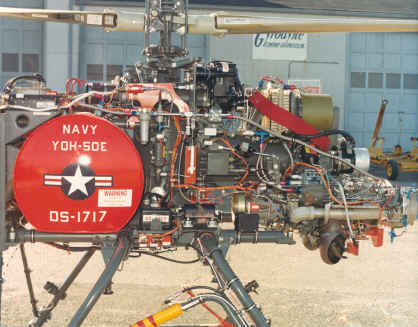 As the QH-50E was produced in a
limited amount, its U.S. Naval service history is limited to the testing of the
engine combination only. Upon the engine qualification that the Navy accepted,
all further QH-50 orders were cancelled in 1969 due to Navy down-sizing and the
scrapping of many of the ships the QH-50 operated from.
As the QH-50E was produced in a
limited amount, its U.S. Naval service history is limited to the testing of the
engine combination only. Upon the engine qualification that the Navy accepted,
all further QH-50 orders were cancelled in 1969 due to Navy down-sizing and the
scrapping of many of the ships the QH-50 operated from.
As the Allison powered QH-50E was
seen then, as it is today, as the progenitor to expand the mission capabilities
so adequately illustrated by the D model, we herein submit a detailed
description of the E model to illustrate what an Allison powered QH-50 would
look like.
The Difference
The only difference between the D and E
model QH-50, consist of installing a new engine and engine attachment (see
photo-above left), and altering the direction of flight, which is the reverse of the
Model QH-50D in that the engine is installed aft of the rotor mast and the
avionics equipment, flotation equipment and fuel tank are forward of the mast.
Like the D model, the QH-50E rotor system
is of the two-bladed coaxial semi-rigid type, incorporating fiberglass blades of
a 2:1 taper ratio with a negative twist of 12 degrees. The Model QH-50E was
designed like the D, to be capable of carrying and launching two (2) MK44
Torpedoes, or one MK46 Torpedo, or a special weapon payload of 1500 lbs.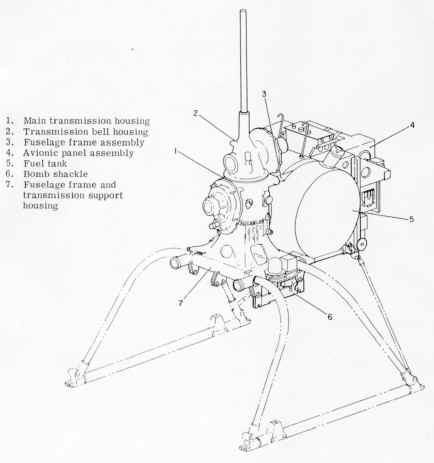
The Fuselage
The lower casting of the transmission forms
the main portion of the fuselage. Attached to the casting are the four
supporting struts for the skid-type landing gear, the bomb shackle mechanisms,
and two upper and two lower support tubes. The fuel tank is mounted on the lower
two tubes of the forward truss assembly and is positioned directly ahead of the
transmission casting. The tank is further secured by a forward panel and the
upper two tubes of the forward truss assembly. This panel also serves as a
mounting board for some components of the Automatic Stabilization and Remote
Control Equipment (ASCE), as well as other equipment such as flotation gear and
operational telemetry; see figure at right.
The Transmission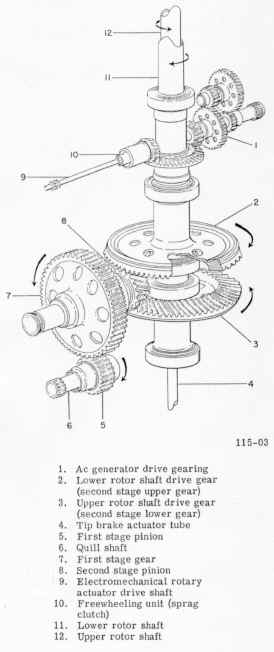
The rotor transmission system consists of a
two-stage gear reduction system, two rotor drive shafts, an integral lubricating
system, a generator drive, and a four-axis servo actuator drive. Power from the
engine is transmitted to the rotors through the two-stage gear reduction; the
second stage of which divides the torque to the two contra- rotating coaxial
rotor drive shafts. The generator drive and four-axis servo actuator drive are
connected by gears to the outer (lower) rotor drive shaft.
The Rotor System
Two 2-bladed semi-rigid contra-rotating
coaxial rotors comprise the rotor system. The blades are of glass fiber
reinforced plastic construction - incorporating linear taper in planform and
thickness and 12 degrees negative twist. The Model QH-50E vehicle is completely
controllable through the rotors. Rotor controls are operated by the Automatic
Stabilization and Remote Control Equipment (ASCE). Control in pitch and roll is
achieved through conventional cyclic control of the swash plates. Collective
pitch control is obtained by conventional collective movement of the swash
plates. Control in yaw is achieved by means of rotor blade tip-mounted air
(drag) brakes. Movable tip brakes are located at the tips of both the upper and
lower rotor blades and provide, by their deflection, positive directional
control in all conditions of flight by creating an unequal torque distribution
in the rotor system. A left turning moment results from lower rotor tip brake
deflection while a right turning moment results from upper
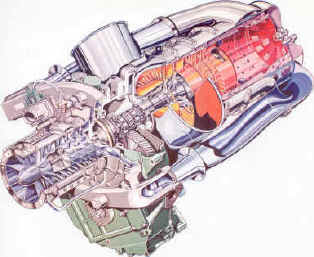 rotor tip brake
deflection. In the neutral condition, both sets of tip brakes are undeflected.
rotor tip brake
deflection. In the neutral condition, both sets of tip brakes are undeflected.
Power Plant
The power plant for the Model
QH-50E vehicle is the T63-A-5A, Model
250-C19A, Allison gas turbine engine. The gas producer section is composed of a
combination six-stage axial flow one-stage centrifugal flow compressor directly
coupled to a two-stage gas producer turbine. The
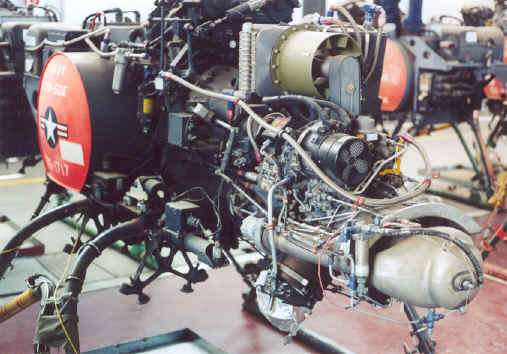 power turbine section is
composed of a two-stage free turbine which is gas coupled to the gas producer
turbine.
The engine incorporates an integral reduction gear box which provides an
internal spline output drive at the front of the gear box. The power plant has a
take-off power rating of 317 SHP at 6,000 rpm, at sea level standard conditions.
The engine is attached rigidly, by means of a cast aluminum mount, to what is
now the rear face of the transmission. This face was fwd and where the Boeing
engine was mounted in the QH-50D. The engine intake is behind and below the
transmission and faces forward and the engine exhaust is directed outward and
downward. A transmission input power drive shaft connects the engine with the
transmission first stage gear system and runs inside the engine mount.
power turbine section is
composed of a two-stage free turbine which is gas coupled to the gas producer
turbine.
The engine incorporates an integral reduction gear box which provides an
internal spline output drive at the front of the gear box. The power plant has a
take-off power rating of 317 SHP at 6,000 rpm, at sea level standard conditions.
The engine is attached rigidly, by means of a cast aluminum mount, to what is
now the rear face of the transmission. This face was fwd and where the Boeing
engine was mounted in the QH-50D. The engine intake is behind and below the
transmission and faces forward and the engine exhaust is directed outward and
downward. A transmission input power drive shaft connects the engine with the
transmission first stage gear system and runs inside the engine mount.

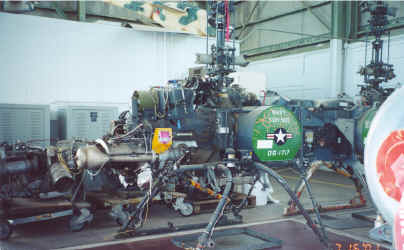 Today, there is only one
QH-50E that survives of the three originally converted from D models; that being
DS-1717 (see below for the fate of DS-1718 and DS-1719). DS-1717 resides
in a storage building at White Sands Missile Range, New Mexico, parked among
some 20 surviving QH-50D model aircraft requiring overhaul before flight.
Today, there is only one
QH-50E that survives of the three originally converted from D models; that being
DS-1717 (see below for the fate of DS-1718 and DS-1719). DS-1717 resides
in a storage building at White Sands Missile Range, New Mexico, parked among
some 20 surviving QH-50D model aircraft requiring overhaul before flight.
While DS-1717 sits among
it brethren D models, its future is uncertain as its' uniqueness as a prototype
invalidates its further use other than for parts for the D models currently
flown for Army missions. The
Gyrodyne
Helicopter Historical Foundation is dedicated to the saving of this
"one of a kind" aircraft so that future generations can see the
combining of the QH-50 Co-Axial rotor system to the currently available Allison
(now Rolls Royce) 250 series engine. Its use as an educational tool illustrating
that engine-coaxial rotor combination, is incalculable.

Despite the QH-50E being a prototype
aircraft, the increase in payload due to the lower weight Allison engine
provides such increased benefits, that the information below is herein provided
so that the performance criteria using the lower horse powered C-19 can be seen;
Imagine if this aircraft had the use of the Allison 250-C20B (420 Shp).......
Serial Number History
QH-50E Drone (also known as YQH-50E)
|
Serial Numbers
|
Number Produced
|
Manufacture Date
|
Disposition
|
| DS-1717 (seen above) |
1 |
Originally accepted as a D
model in April 1969
Returned and remanufactured as an E model in August 1969
|
Built under contract N00019-69-C-0361,
DS-1717 originally was a QH-50D that was returned to Gyrodyne under a
bailment agreement that included DS-1717,18 and 19. Delivered to
NATC-Patuxent River, MD for stability and control tests, engine problems
caused DS-1717 to be grounded while performing ground vibration tests. The
program was cancelled before DS-1717 could be returned to service. It is
presently stored in a U.S. Army Warehouse in New Mexico awaiting
disposition. |
| DS-1718 |
1 |
Originally accepted as a D
model in April 1969
Returned and remanufactured as an E model in August 1969
|
DS-1718, after completing preliminary control
flights, was returned to Gyrodyne and converted into a two place, manned
test bed for the 24' rotor system in which the Allison engine remained
installed. Unfortunately, DS-1718 was destroyed in a trucking accident
while being transported to California in November 16, 1999. |
| DS-1719 |
1 |
Originally accepted as a D
model in April 1969
Returned and remanufactured as an E model in August 1969
|
DS-1719, upon acceptance by the Navy, was the
more used E model during contractor demonstrations at NATC-Patuxent River,
MD. It was used to attain information on the Allison engine installation
and validity of its design. Unfortunately, a "hunting" problem
would occur when the aircraft was close to the ground as the engine's fuel
controller attempted to match the power required to maintain the set
altitude the automatic flight control system was trying to maintain
through increasing pitch of the rotor hubs. A time lag between when the
power was needed and when it was delivered caused the engine systems to
search for a balance of power. Gyrodyne attempted to fix the problem but
this problem led to the loss of DS-1719 when it crashed while landing in
November 1969. At that point the Allison powered YQH-50E development
contract was cancelled. |

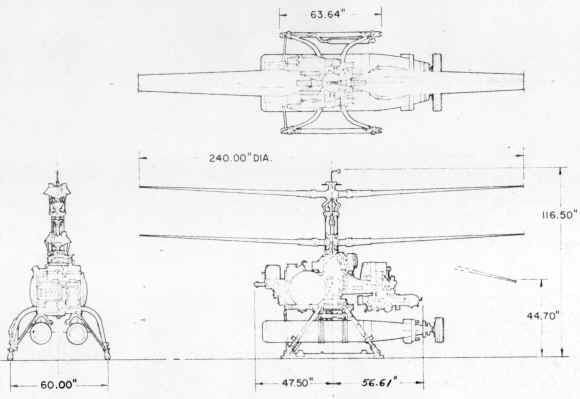
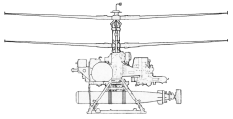
![]()
![]()